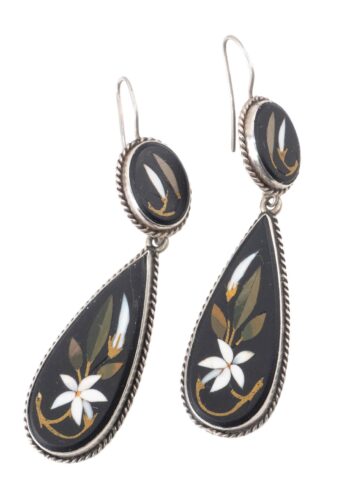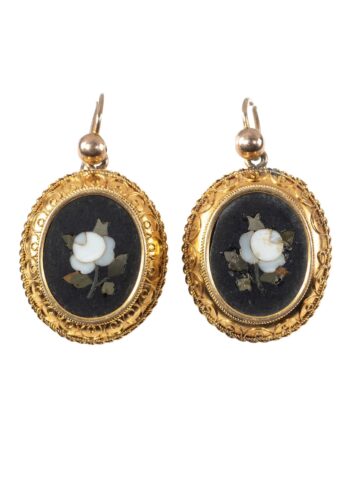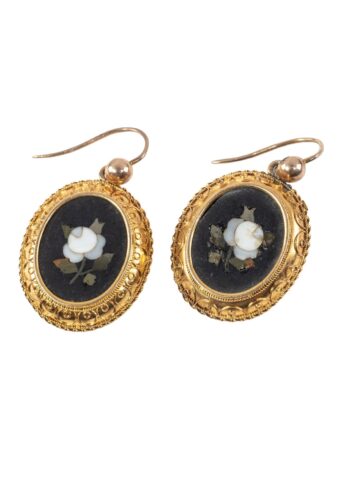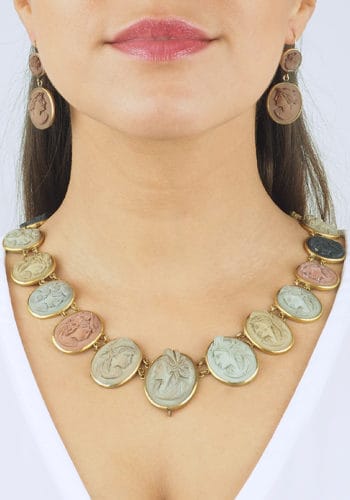
Lava / Micromosaics & Pietra Dura
The term 'micromosaic” means to us as jewellery historians one of the most adroit techniques in the antique jewellery creation of Europe. Still today pieces of art from Italy please us, which stimulate to the amazement and incredulous shaking of the head. The putting of millimetre-small glass pieces to micromosaics of excessive imagination with a sound love for colours is meant here. In this manner representations of plants and animals were created with the help of tweezers set in golden and silver frames.
The setting of whole landscapes and places of interest of Italy on centimetre-small ground require highest precision and an extremely quiet hand. These fine ‚paintings of glass‘ are exceedingly astonishing! An also current term for this special jewellery is ‚Millefiori‘. Originally the word Millefiori means a glass product made from multi colour layers since ancient times. Just a few people at the Vatican know the technical skill to place micromosaics nowadays. If, for example, one likes to let restore a micromosaic piece of jewellery, one has to anticipate waiting periods of several years. Rome was not built on one day also… Another purely Italian speciality of the artistic jewellery manufacturing is based on the craft of lapidary. In the antique jewellery these works are known as ‚a Pietra-Dura‘ or mostly also as ‚Florentine mosaic‘.
More than 400 years ago already in Tuscany developed, more exactly said in Florence, the extremely costly art of cutting of noble stone plates. Then these are composed by the artist with various techniques to, perceived as gapless, pictorial representations. Popular motives of these exact works were always blossoms and leaves. To let the pictures appear so colourful and nearly three-dimensional, different gem stones and organic materials are combined with each other. For the application agates, jasper, malachite and coloured marble types from all over the world were used. Further partial coral and mother-of-pearl are found in the pieces of art. The anyway quite decorative radiation of the single colour stones grows in the complete antique Pietra-Dura pieces of jewellery to an intriguing overall impression. The ‚inlaid works‘, were the colour stones put in before designed and low-cut recesses, were set in narrow golden frames. Therefore nothing deflects the attention of the viewer of the Florentine mosaic.
Click to fold
The setting of whole landscapes and places of interest of Italy on centimetre-small ground require highest precision and an extremely quiet hand. These fine ‚paintings of glass‘ are exceedingly astonishing! An also current term for this special jewellery is ‚Millefiori‘. Originally the word Millefiori means a glass product made from multi colour layers since ancient times. Just a few people at the Vatican know the technical skill to place micromosaics nowadays. If, for example, one likes to let restore a micromosaic piece of jewellery, one has to anticipate waiting periods of several years. Rome was not built on one day also… Another purely Italian speciality of the artistic jewellery manufacturing is based on the craft of lapidary. In the antique jewellery these works are known as ‚a Pietra-Dura‘ or mostly also as ‚Florentine mosaic‘.
More than 400 years ago already in Tuscany developed, more exactly said in Florence, the extremely costly art of cutting of noble stone plates. Then these are composed by the artist with various techniques to, perceived as gapless, pictorial representations. Popular motives of these exact works were always blossoms and leaves. To let the pictures appear so colourful and nearly three-dimensional, different gem stones and organic materials are combined with each other. For the application agates, jasper, malachite and coloured marble types from all over the world were used. Further partial coral and mother-of-pearl are found in the pieces of art. The anyway quite decorative radiation of the single colour stones grows in the complete antique Pietra-Dura pieces of jewellery to an intriguing overall impression. The ‚inlaid works‘, were the colour stones put in before designed and low-cut recesses, were set in narrow golden frames. Therefore nothing deflects the attention of the viewer of the Florentine mosaic.
Click to fold
-
Ca. 1870 – Victorian earrings
€ 990,00
Differential tax applies collectors items and antiques in accordance with German law §25a UStGFree Shipping -
Ca. 1870 – Pietra Dura earrings
€ 1.590,00
Differential tax applies collectors items and antiques in accordance with German law §25a UStGFree Shipping -
Ca. 1870 – Micro mosaic-Earrings with Gold frames, Motifs of antique Roman buildings
€ 1.690,00
Differential tax applies collectors items and antiques in accordance with German law §25a UStGFree Shipping -
Ca. 1850 – 18 ct. Gold Brooch Micro-mosaic “St. Peter’s Square” Italy
€ 990,00
Differential tax applies collectors items and antiques in accordance with German law §25a UStGFree Shipping -
Ca. 1850 – Pietra Dura / 15 Carat Yellow-gold Earrings
€ 1.390,00
Differential tax applies collectors items and antiques in accordance with German law §25a UStGFree Shipping -
Ca. 1860 – Complete Parure from Italy, with multi-coloured Lava cameos and gold-plated frames
€ 4.900,00
Differential tax applies collectors items and antiques in accordance with German law §25a UStGFree Shipping -
Ca. 1870 – Micro mosaics Set Necklace & Earrings English/Italian
€ 1.590,00
Differential tax applies collectors items and antiques in accordance with German law §25a UStGFree Shipping -
Ca. 1850 – Lava Set Bracelet, Brooch & Earrings Italy
€ 1.900,00
Differential tax applies collectors items and antiques in accordance with German law §25a UStGFree Shipping


















